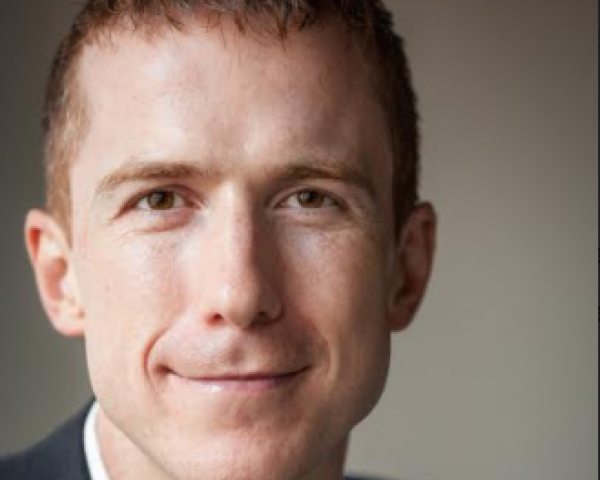Don’t Forget Your Best Strategic Weapon
When clients feel that their provider is very engaged, 98% provide referrals to their advisers during the course of a year.

When clients feel that their provider is very engaged, 98% provide referrals to their advisers during the course of a year.

Get Involved
Our authors are what set Insurance Thought Leadership apart.
|
Partner with us
We’d love to talk to you about how we can improve your marketing ROI.
|
Will this be the year that the U.S. insurance industry moves toward level commissions or fee-based products across all product lines?

Get Involved
Our authors are what set Insurance Thought Leadership apart.
|
Partner with us
We’d love to talk to you about how we can improve your marketing ROI.
|

Tony Steuer connects consumers and insurance agents by providing "Insurance Literacy Answers You Can Trust." Steuer is a recognized authority on life, disability and long-term care insurance literacy and is the founder of the Insurance Literacy Institute and the Insurance Quality Mark and has recently created a best practices standard for insurance agents: the Insurance Consumer Bill of Rights.
Disruptors’ natural and essential super-confidence in themselves can translate into overconfidence in the ethical correctness of their decisions.

Get Involved
Our authors are what set Insurance Thought Leadership apart.
|
Partner with us
We’d love to talk to you about how we can improve your marketing ROI.
|

Duncan Minty is an independent ethics consultant with a particular interest in the insurance sector. Minty is a chartered insurance practitioner and the author of ethics courses and guidance papers for the Chartered Insurance Institute.
Long ago, our home appliances became electrified. Soon, they will be “cognified” because of the spread of bots and the AI inside.

Get Involved
Our authors are what set Insurance Thought Leadership apart.
|
Partner with us
We’d love to talk to you about how we can improve your marketing ROI.
|

Vivek Wadhwa is a fellow at Arthur and Toni Rembe Rock Center for Corporate Governance, Stanford University; director of research at the Center for Entrepreneurship and Research Commercialization at the Pratt School of Engineering, Duke University; and distinguished fellow at Singularity University.
Insurers have unbelievably broad data -- but that won't matter unless we embrace an entirely new field of knowledge.

Get Involved
Our authors are what set Insurance Thought Leadership apart.
|
Partner with us
We’d love to talk to you about how we can improve your marketing ROI.
|

Denise Garth is senior vice president, strategic marketing, responsible for leading marketing, industry relations and innovation in support of Majesco's client-centric strategy.
Let’s look at the best-case and worst-case scenarios for a world where all things are instrumented, monitored, analyzed and automated.

What will the world look like in 2030? As the world becomes increasingly connected, will technology free the human race and solve the age-old problems of the world? Or will it lead to chaos and misery? Utopia or dystopia – what’s it gonna be? This may seem like just philosophical prognostication – and it is – but it turns out that there are huge implications for the insurance industry that should be considered. Let’s look at the best-case and worst-case scenarios that could result from a world where all things – living and non-living – are instrumented, monitored, analyzed and automated.
Utopian View
Utopian novels always seem to have an important element of technology progress to enable a better world (although they also tend to have political dimensions, as well). Assessing the current state of technology and the potential advancements of various emerging technologies with optimism yields a future that may have the following characteristics – or the utopian view:
Humanity has a way of messing things up. Every new societal and technology advancement seems to bring new problems. There is little doubt that emerging technologies will transform our world substantially by 2030, but it is possible that the misuse and abuse of those technologies will lead to disaster, looking something like the following – or the dystopian view:
In the most extreme dystopia, we could consider end of world (EOW) scenarios – popular in science fiction today, but we won’t go there in this blog.
Insurance Implications
Both of the worlds painted here – a wonderful utopia and a tragic dystopia – are extreme. The most likely future will have some elements of both the utopian and dystopian views. We are already on a path toward many of these conditions – both good and bad.
Does it make any difference for the insurance industry? You bet!
On one hand, the insurance industry exists to help manage bad scenarios, even the types described in the dystopian view. On the other hand, the industry could play a central role in the utopian view, helping to make the world a better, safer, more enjoyable place to live. While these possibilities may seem far off or far out, the early stages of many are already underway.
See also: A New World Full of Opportunity
Insurance strategists would be wise to consider all of these possible future conditions via scenario-planning exercises. Various combinations of these situations would result in dramatically different implications for the industry. Identifying those implications that show up as likely in most or all scenarios is a good place to start. These scenarios have such massive implications for insurance that it is important to start considering them now. Because 2030 will be here before we know it.
Get Involved
Our authors are what set Insurance Thought Leadership apart.
|
Partner with us
We’d love to talk to you about how we can improve your marketing ROI.
|

Mark Breading is a partner at Strategy Meets Action, a Resource Pro company that helps insurers develop and validate their IT strategies and plans, better understand how their investments measure up in today's highly competitive environment and gain clarity on solution options and vendor selection.
It is my strong belief that any successful remake of healthcare will need to build from the success of President Obama’s signature legislation.

Get Involved
Our authors are what set Insurance Thought Leadership apart.
|
Partner with us
We’d love to talk to you about how we can improve your marketing ROI.
|

Craig Hasday is President of <a href="http://frenkelbenefits.com/">Frenkel Benefits</a> and Senior Executive Vice President of Frenkel and Company. Frenkel Benefits is one of the largest privately held independent employee benefits brokers in the United States. He is a nationally recognized healthcare leader, who has sat on the national advisory boards of Aetna, UnitedHealthcare and WellPoint, as well as the regional advisory boards of most major carriers.
Denial of service attack showed there are new forms of systemic risks that could threaten the solvency of major insurers.

We are entering a new era for global insurers, one where business interruption claims are no longer confined to a limited geography but can simultaneously have an impact on seemingly disconnected insureds globally. This creates new forms of systemic risks that could threaten the solvency of major insurers if they do not understand the silent and affirmative cyber risks inherent in their portfolios.
On Friday, Oct. 21, a distributed denial of service attack (DDoS) rendered a large number of the world’s most popular websites — including Twitter, Amazon, Netflix and GitHub — inaccessible to many users. The internet outage conscripted vulnerable Internet of Things (IoT) devices such as routers, DVRs and CCTV cameras to overwhelm DNS provider Dyn, effectively hampering internet users' ability to access websites across Europe and North America. The attack was carried out using an IoT botnet called Mirai, which works by continuously scanning for IoT devices with factory default user names and passwords.
The Dyn attack highlights three fundamental developments that have changed the nature of aggregated business interruption for the commercial insurance industry:
1. The proliferation of systemically important vendors
The emergence of systemically important vendors can cause simultaneous business interruption to large portions of the global economy.
The insurance industry is aware about the potential aggregation risk in cloud computing services, such as Amazon Web Services (AWS) and Microsoft Azure. Cloud computing providers create potential for aggregation risk; however, given the layers of security, redundancy and the 38 global availability zones built into AWS, it is not necessarily the easiest target for adversaries to cause a catastrophic event for insurers.
See also: Who Will Make the IoT Safe?
There are potentially several hundred systemically important vendors that could be susceptible to concurrent and substantial business interruption. This includes at least eight DNS providers that service over 50,000 websites — and some of these vendors may not have the kind of security that exists within providers like AWS.
2. Insecurity in the Internet of Things (IoT) built into all aspects of the global economy
The emergence of IoT with applications as diverse as consumer devices, manufacturing sensors, health monitoring and connected vehicles is another key development. Estimates state that anywhere from 20 to 200 billion everyday objects will be connected to the internet by 2020. Security is often not being built into the design of these products with the rush to get them to market.
Symantec’s research on IoT security has shown the state of IoT security is poor:
The Dyn attack compromised less than 1% of IoT devices. By some accounts, millions of vulnerable IoT devices were used in a market with approximately 10 billion devices. XiongMai Technologies, the Chinese electronics firm behind many of the webcams compromised in the attack, has issued a recall for many of its devices.
Outages like these are just the beginning.
Shankar Somasundaram, senior director, Internet of Things at Symantec, expects more of these attacks in the near future.
3. Catastrophic losses because of cyber risks are not independent, unlike natural catastrophes
A core tenant of natural catastrophe modeling is that the aggregation events are largely independent. An earthquake in Japan does not increase the likelihood of an earthquake in California.
In the cyber world consisting of active adversaries, this does not hold true for two reasons (which require an understanding of threat actors).
First, an attack on an organization like Dyn will often lead to copycat attacks from disparate non-state groups. Symantec maintains a network of honeypots, which collects IoT malware samples. A distribution of attacks is below:
Groups such as New World Hacking often replicate attacks. Understanding where they are targeting their time and attention and whether there are attempts to replicate attacks is important for an insurer to respond to a one-off event.
See also: Why More Attacks Via IoT Are Inevitable
A key aspect to consider in cyber modeling is intelligence about state-based threat actors. It is important to understand both the capabilities and the motivations of threat actors when assessing the frequency of catastrophic scenarios. Scenarios where we see a greater propensity for catastrophic cyber attacks are also scenarios where those state actors are likely attempting multiple attacks. Although insurers may wish to seek refuge in the act of war definitions that exist in other insurance lines, cyber attack attribution to state-based actors is difficult — and, in some cases, not possible.
What does this mean for global insurers?
The Dyn attack illustrates that insurers need to pursue new approaches to understanding and modeling cyber risk. Recommendations for insurers are below:
Symantec is partnering globally with leading insurers to develop probabilistic, scenario-based modeling to help understand cyber risks inherent in standalone cyber policies, as well as cyber as a peril across all lines of insurance. The Internet of Things opens up tremendous new opportunities for consumers and businesses, but understanding the financial risks inherent in this development will require deep collaboration between the cyber security and cyber insurance industries.
Get Involved
Our authors are what set Insurance Thought Leadership apart.
|
Partner with us
We’d love to talk to you about how we can improve your marketing ROI.
|

Pascal Millaire is the CEO of CyberCube, a Symantec Ventures company dedicated to providing data-driven cyber underwriting and aggregation management analytics to the global insurance industry.
One misconception among buyers is exposure. For example, who bears the liability if a third party, such as a payroll service, causes the breach?

 “Companies should know first where their data is residing, what type of data they are holding, and the security around their network and their employees,” Marciano says.
Some of the main categories of cyber insurance coverage are:
“Companies should know first where their data is residing, what type of data they are holding, and the security around their network and their employees,” Marciano says.
Some of the main categories of cyber insurance coverage are:
Get Involved
Our authors are what set Insurance Thought Leadership apart.
|
Partner with us
We’d love to talk to you about how we can improve your marketing ROI.
|

Byron Acohido is a business journalist who has been writing about cybersecurity and privacy since 2004, and currently blogs at LastWatchdog.com.
We service professionals all too often tend to define our business model in terms of products and services offered rather than clients served.

Get Involved
Our authors are what set Insurance Thought Leadership apart.
|
Partner with us
We’d love to talk to you about how we can improve your marketing ROI.
|

Mike Manes was branded by Jack Burke as a “Cajun Philosopher.” He self-defines as a storyteller – “a guy with some brain tissue and much more scar tissue.” His organizational and life mantra is Carpe Mañana.